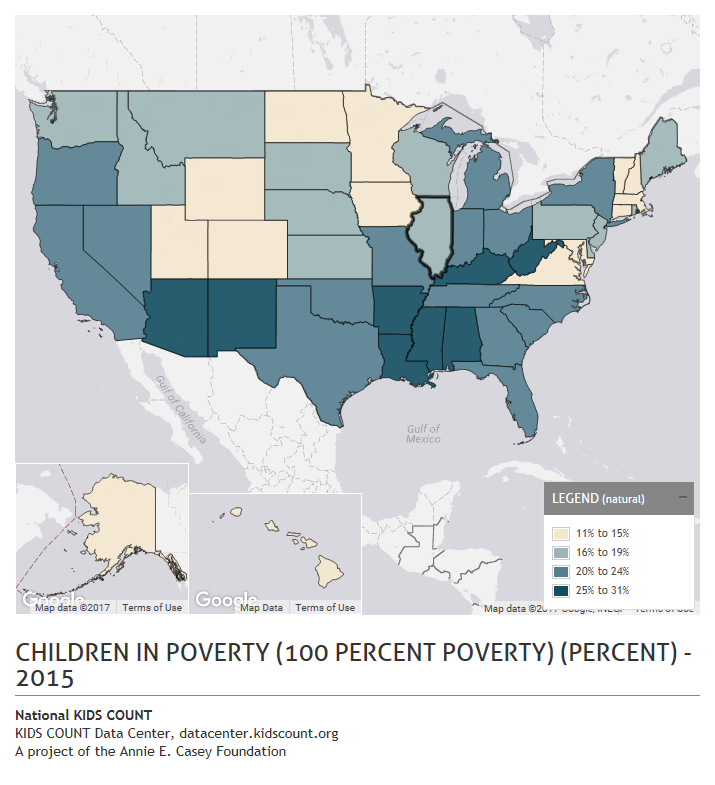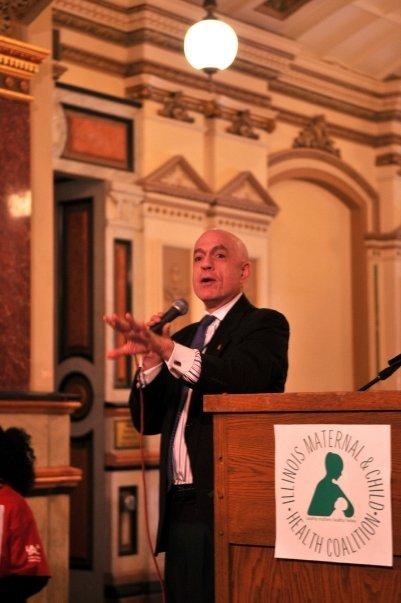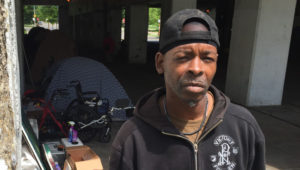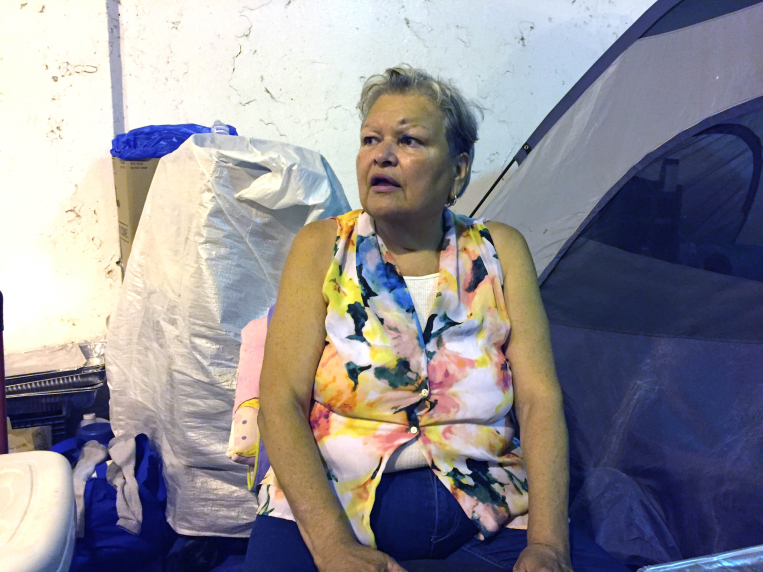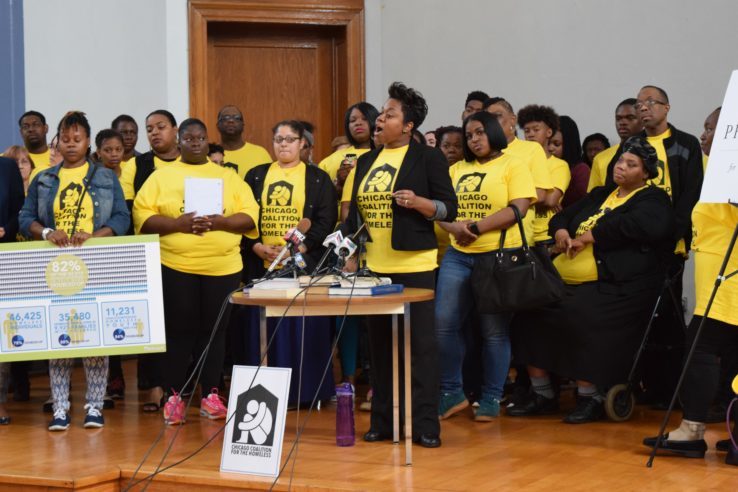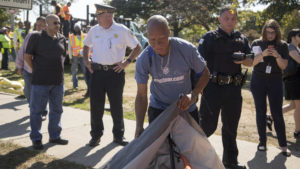
By Mary Wisniewski and Marissa Page
The city of Chicago cleared out what was left of the former homeless encampments under Lake Shore Drive in Uptown on Monday morning and required residents to leave a nearby parkway, while advocates abandoned their attempts in court to block the city from starting construction on the crumbling structures.
Representatives from the Chicago Coalition for the Homeless withdrew a request for a temporary restraining order they hoped would delay work on the Wilson and Lawrence avenue bridges, a six-month construction project that required more than two dozen homeless people living under the bridges to move elsewhere. The bridges were built in 1933 and are among the most traveled structurally deficient structures in the city, according to the American Road & Transportation Builders Association, a Washington-based trade group.
The coalition sought permanent housing options for the tent city residents, and say that the city’s plans for bike paths on the sidewalks at Lawrence and Wilson are intended to block the homeless from returning.
“We believe they are intentionally discriminatory,” coalition attorney Patricia Nix-Hodes told reporters after the hearing, referring to the construction plans.
Construction could begin as soon as Tuesday, according to Chicago Department of Transportation spokeswoman Susan Hofer, and is scheduled to continue until March 31.
The tent city residents had relocated their tents to a grassy parkway just west of the bridges Sunday. Streets and Sanitation workers tossed blankets, food, mattresses and a tent left under the Lawrence bridge into blue garbage trucks early Monday.
Later in the morning, police began ordering the former tent city residents to leave the new spot they picked along the public way bordering Wilson and Marine Drive.
Chicago police Cmdr. Marc Buslik said CDOT workers would seize tents and belongings from those who did not comply with the order to move, and that remaining residents would receive citations. However, Hofer said CDOT would not have confiscated tents and belongings.
“Our role is enforcing the freedom of the public way, and by filing complaints with the Police Department we did that,” Hofer said. She said the tents were so close to the street that if someone had tripped and fallen out of a tent, he or she could have been run over. “We wanted them to be safe.”
About 10:45 a.m., officers stationed themselves behind the encampment along Wilson as some residents began packing their possessions. City workers began removing tents and belongings just before 11:15 as supporters chanted, “Stop harassing the homeless.”
Deputy Chief Al Nagode said the residents’ personal effects were being taken to the North Area Community Service Center at 845 W. Wilson, which is operated by the city’s Family and Support Services Department.
Nagode said residents had to leave because their tents were in a permitted area for construction.
By noon Monday, most of the tents on the parkway had been dismantled and the enforcement left people scrambling to find alternatives. One man asked officers for some additional time to vacate the area, as he tried to secure a different housing arrangement. Several residents said they had not determined where they would head next.
City officials said they have been working with the homeless and trying to find them alternative housing. But many of the people interviewed say they don’t want the shelter offered.
Maggie Gruzlewski, 49, who has depression as well as multiple physical problems, said her pocket has been picked at a shelter and she doesn’t want to stay there.
“I have a hard time sleeping there,” she said. “It’s noisy. There are bedbugs.”
She said she’s on a waiting list for housing and has been homeless for six months.
A former resident at the Lawrence bridge, Senad Filan, 45, was in tears. He thought he would get a key to an apartment Monday from an advocacy group. But it didn’t come, and now he was not sure what would happen. He said he had been homeless for five years.
“You try to be calm and be patient,” said Filan, wiping his eyes as he stood by his collapsed tent, decorated with a Blackhawks scarf. “Some friends are going to help me.”
Andrew Worseck, an attorney for the city, told Cook County Circuit Judge Celia Gamrath in court on Monday that the city had also arranged for shelter beds in Uptown, and that more shelter options are being added daily. City officials had proposed moving the tent city residents to the Pacific Garden Mission in the South Loop, about 8 miles away.
But attorneys for the coalition countered that the shelter beds in Uptown were for men only, and that the Pacific Garden Mission did not have facilities for the mentally ill. Many tent city residents said they rejected an offer from the city to go to the South Loop facility for similar reasons, and also because it requires participation in religious services.
Yehuda Rothschild, one of the founders of Uptown Tent City Organizers, said residents and advocates were hoping that a permanent housing option from the city would materialize by Monday. Hope was a “long shot,” but residents had few other options, he said.
“These are people at the end of their rope,” Rothschild said. “They can’t help themselves or they would.”
Julian Andrews, 37, said he began living under the Lawrence viaduct after losing his previous housing. He said he scraped together enough money to stay in a hotel Sunday night and returned to the neighborhood to collect his possessions from the bridge.
By the time he arrived Monday morning, city crews had cleared the area, and his things were gone. He said did not know whether his belongings had been thrown away or moved someplace else.
“I’m lost, man. I’m lost more than I already was,” Andrews said through tears.

 Louis “Abdul” Jones and other homeless occupants of two tent encampments moved their belongings to a nearby parkway Sunday in hopes of avoiding a forced city eviction. | Mark Brown/Sun-Times
Louis “Abdul” Jones and other homeless occupants of two tent encampments moved their belongings to a nearby parkway Sunday in hopes of avoiding a forced city eviction. | Mark Brown/Sun-Times